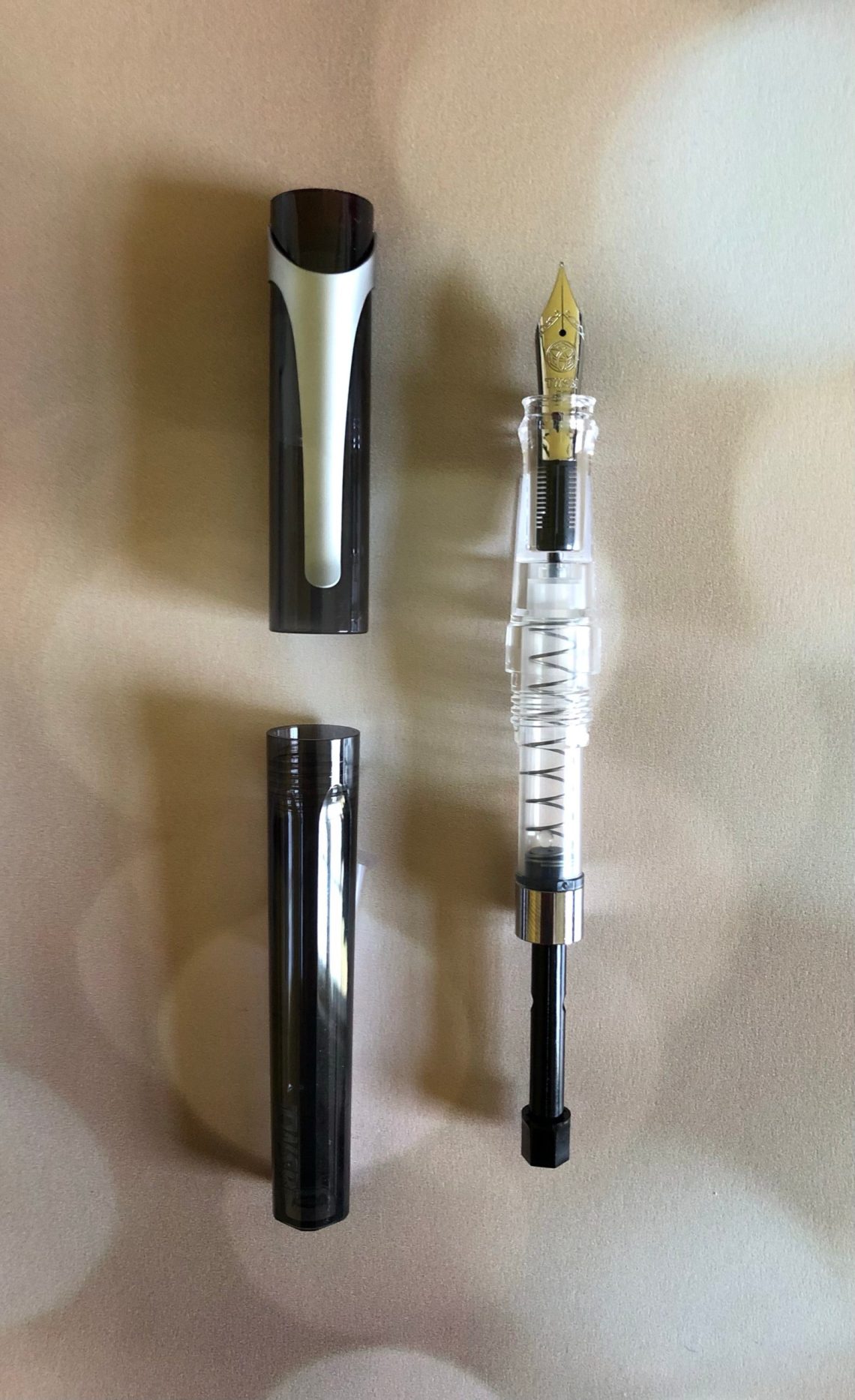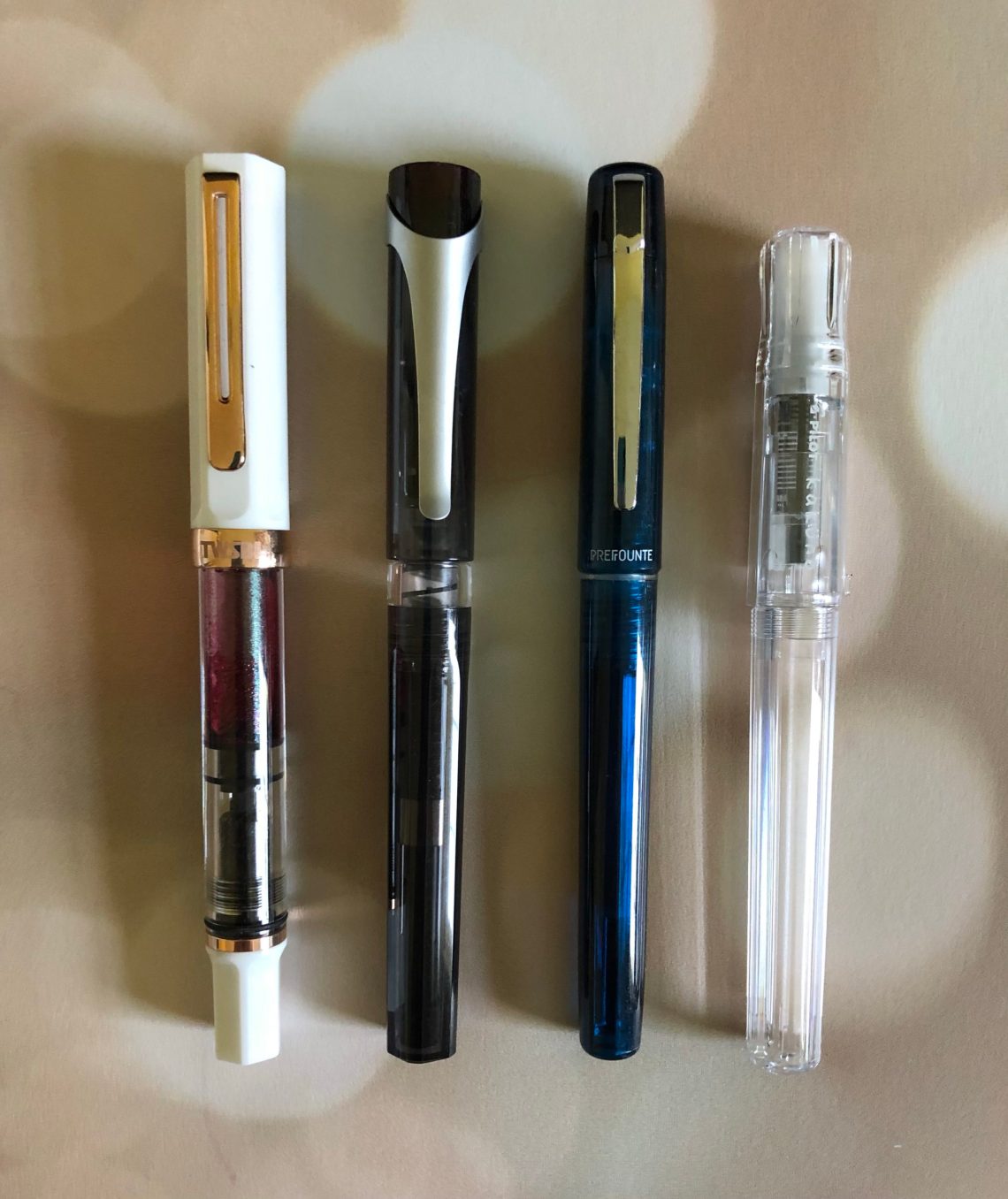Review by Tina Koyama
In case you missed it, Part 1 of Multi Madness included three multi pens with unique components. This review includes four multis with ink and graphite components: the Bic 4-Color 3 + 1, the Uni Jetstream 4&1, the Zebra Sarasa Multi 4 Color and the Zebra Clip-on 1000S 4 Color.

My fondness for multi pens goes way back. My first was the Bic 4-Color Pen, the now-iconic multi pen that was introduced in 1970 by French entrepreneur Marcel Bich. It seems basic now, but as a teen, I thought it was the coolest thing ever to have four ink colors in one compact pen. I could write a diary entry in blue or black, then emphasize certain passages with swirly hearts and flowers in red and green! Beyond nostalgic value, the ubiquitous Bic still contains the oily, (and unfortunately) blobby ink that I find to be the ideal ballpoint ink for drawing. The color range has expanded, too.

A while back, a different Bic 4-Color came to my attention: the 4-Color 3 + 1 (about $6). Actually, it has only three ink colors (I don’t miss green), and the fourth component is a mechanical pencil. In general, I’m not a fan of drawing with mechanical pencils, but having a graphite option with my beloved Bic ink does make this Swiss army knife of drawing tools more versatile.




As soon as I got it, I noticed a difference. The body shape is slightly different from the classic 4-Color, and – more significantly – the mechanism of the slidey levers is much smoother and operates better. While most Bic 4-Colors are made in France, reading the fine print on the packaging revealed that the model with the graphite component is made in Japan. To my relief, the ink remains the same Bic ink.
The pencil unit includes 0.7mm lead instead of the more typical 0.5mm lead in other multi pens. I have a heavy-handed habit of snapping most 0.5mm leads, so this was good news to me; I prefer 0.7mm for both writing and drawing. To my mind, nostalgically and practically, the Bic will always be the ballpoint multi pen to beat.

And let’s face it: In most ways, it’s not hard to beat the Bic. The other three multis in this review all have smoother, more vibrant inks than the Bic, and the bodies are generally better, too. They all write and erase competently, as you’d expect from Uni and Zebra, so most of my comparisons are about the bodies. Below are scribble and erasing samples made in a Plumchester sketchbook, which has a smooth surface. Erasing was done with the attached eraser.

When I first got one several years ago, the Uni Jetstream 4&1 ($11.75) instantly became a daily-carry. With Uni’s smooth black, blue, red and green ballpoint inks plus a 0.5mm mechanical pencil, it’s a reliable quick jotter. The plastic body has a metallic sheen like anodized aluminum, and the rubberized grip is comfy. The selector buttons are a bit springy when they snap back, but they engage securely and easily.




For writing, Jetstream ink is leaps and bounds better than Bic. Unfortunately for me, that “revolutionary low-viscosity Jetstream ink” that is so wonderful to write with just doesn’t have the same subtle build-up for drawing as Bic’s viscous formula.
Still, there are many more ink + mechanical pencil multi pens to try, and try more I did. Zebra Sarasa gel pens in all styles have long been favorites, so the Zebra Sarasa Multi 4 Color ($7.50) was a natural choice. You can’t beat gel for lots of colors and sizes to choose from. (I’m still deciding which colors to swap out for the basic 0.5mm black, blue, red and green it comes with.)




The Sarasa’s trademark squeezy clip is also the lever for the 0.5mm mechanical pencil. I don’t use pen clips, so it doesn’t bother me, but I wonder if the motion of clipping it to a pocket could inadvertently select the lead. More bothersome to me, however, is that the ink selector levers are nearly flush with the pen body, making them more difficult to push, and they don’t always engage. Springy and bouncy like the Jetstream’s levers, they are probably a joy for people who like to fidget with things.
Speaking of fidgeting, when no components are selected, the Sarasa’s top button (which covers the eraser) bounces up and down simultaneously with all five selector levers with no apparent function. However, when the mechanical pencil unit is already engaged, then the top button’s function is to extend more lead. This is a bit counterintuitive, as on most other multi pens, pushing further on the mechanical pencil selector is what exposes more lead. However, that functionless bouncing would also be fun for fidgeters.
The Zebra multi pen that I prefer to the Sarasa is the Clip-on 1000S 4 Color ($12.50). Without a fidgety top and with selection levers that are easier to push and engage, this multi contains four 0.7mm ballpoint inks plus a 0.5mm mechanical pencil. Ink refills are also available in 0.5mm and 0.4mm.




Like the other Zebra, its squeezy clip has the additional purpose of selecting the graphite component. Unlike the other Zebra, however, pushing the clip further extends more lead. Both Zebra models use the same graphite refills. I’ll probably switch mine out to 0.7mm (you can also choose the 0.3mm size).
Of the four bodies in this review, I think the Uni Jetstream’s anodized aluminum look is the nicest, and it also has the most solid feel and easiest-to-engage slidey levers. The Zebra 1000S Clip-on is a close second.
As a ballpoint sketcher, I couldn’t resist ending the review by comparing the three ballpoint inks side by side. In the sketch of my hand, the black ink is Bic, the red is Zebra, and the blue is Uni Jetstream. It probably isn’t apparent in the sketch, but I was surprised to find that the Zebra’s ballpoint ink felt close to Bic in its ability to layer gradually (similar to graphite). Jetstream is the least satisfying in that way; it lays down a smooth, solid line every time, making it beautiful to write with but not necessarily to draw with. I’m encouraged to draw more now with the Zebra 1000S – an excellent, all-in-one jotting/drawing tool.


DISCLAIMER: Some items included in this review were provided free of charge by JetPens for the purpose of review. And some items in this review include affiliate links. The Well-Appointed Desk is a participant in the Amazon Services LLC Associates Program, an affiliate advertising program designed to provide a means for sites to earn advertising fees by advertising and linking to Amazon.Please see the About page for more details.
 Tina Koyama is an urban sketcher in Seattle. Her blog is Fueled by Clouds & Coffee, and you can follow her on Instagram as Miatagrrl.
Tina Koyama is an urban sketcher in Seattle. Her blog is Fueled by Clouds & Coffee, and you can follow her on Instagram as Miatagrrl.






 So how does the Swipe stack up? Compared to the very slightly more expensive ECO (26.99 vs. 32.99) it’s just a smidge lighter (16g vs. 22g) and every so slightly shorter (5 3/8″/13.5cm vs 5 1/2″/14cm). I also put it against some other introductory pens, the
So how does the Swipe stack up? Compared to the very slightly more expensive ECO (26.99 vs. 32.99) it’s just a smidge lighter (16g vs. 22g) and every so slightly shorter (5 3/8″/13.5cm vs 5 1/2″/14cm). I also put it against some other introductory pens, the 



























































